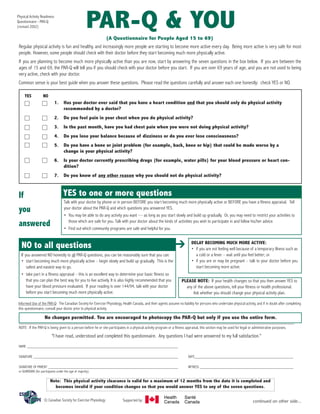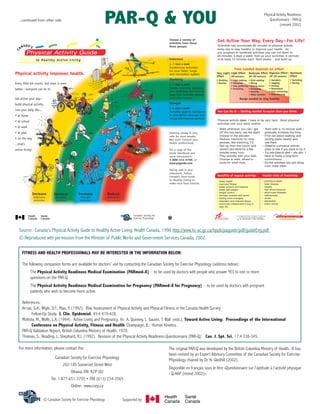Par q
- 1. PAR-Q & YOU Physical Activity Readiness Questionnaire - PAR-Q (revised 2002) (A Questionnaire for People Aged 15 to 69) Regular physical activity is fun and healthy, and increasingly more people are starting to become more active every day. Being more active is very safe for most people. However, some people should check with their doctor before they start becoming much more physically active. If you are planning to become much more physically active than you are now, start by answering the seven questions in the box below. If you are between the ages of 15 and 69, the PAR-Q will tell you if you should check with your doctor before you start. If you are over 69 years of age, and you are not used to being very active, check with your doctor. Common sense is your best guide when you answer these questions. Please read the questions carefully and answer each one honestly: check YES or NO. YES NO 1. 2. Do you feel pain in your chest when you do physical activity? 3. In the past month, have you had chest pain when you were not doing physical activity? 4. Do you lose your balance because of dizziness or do you ever lose consciousness? 5. Do you have a bone or joint problem (for example, back, knee or hip) that could be made worse by a change in your physical activity? 6. Is your doctor currently prescribing drugs (for example, water pills) for your blood pressure or heart condition? 7. If you answered Has your doctor ever said that you have a heart condition and that you should only do physical activity recommended by a doctor? Do you know of any other reason why you should not do physical activity? YES to one or more questions Talk with your doctor by phone or in person BEFORE you start becoming much more physically active or BEFORE you have a fitness appraisal. Tell your doctor about the PAR-Q and which questions you answered YES. ŌĆó You may be able to do any activity you want ŌĆö as long as you start slowly and build up gradually. Or, you may need to restrict your activities to those which are safe for you. Talk with your doctor about the kinds of activities you wish to participate in and follow his/her advice. ŌĆó Find out which community programs are safe and helpful for you. Ō×ö NO to all questions If you answered NO honestly to all PAR-Q questions, you can be reasonably sure that you can: ŌĆó start becoming much more physically active ŌĆō begin slowly and build up gradually. This is the safest and easiest way to go. ŌĆó take part in a fitness appraisal ŌĆō this is an excellent way to determine your basic fitness so that you can plan the best way for you to live actively. It is also highly recommended that you have your blood pressure evaluated. If your reading is over 144/94, talk with your doctor before you start becoming much more physically active. DELAY BECOMING MUCH MORE ACTIVE: ŌĆó if you are not feeling well because of a temporary illness such as a cold or a fever ŌĆō wait until you feel better; or ŌĆó if you are or may be pregnant ŌĆō talk to your doctor before you start becoming more active. PLEASE NOTE: If your health changes so that you then answer YES to any of the above questions, tell your fitness or health professional. Ask whether you should change your physical activity plan. Informed Use of the PAR-Q: The Canadian Society for Exercise Physiology, Health Canada, and their agents assume no liability for persons who undertake physical activity, and if in doubt after completing this questionnaire, consult your doctor prior to physical activity. No changes permitted. You are encouraged to photocopy the PAR-Q but only if you use the entire form. NOTE: If the PAR-Q is being given to a person before he or she participates in a physical activity program or a fitness appraisal, this section may be used for legal or administrative purposes. "I have read, understood and completed this questionnaire. Any questions I had were answered to my full satisfaction." NAME ________________________________________________________________________ SIGNATURE _______________________________________________________________________________ DATE______________________________________________________ SIGNATURE OF PARENT _______________________________________________________________________ or GUARDIAN (for participants under the age of majority) WITNESS ___________________________________________________ Note: This physical activity clearance is valid for a maximum of 12 months from the date it is completed and becomes invalid if your condition changes so that you would answer YES to any of the seven questions. ┬® Canadian Society for Exercise Physiology Supported by: Health Canada Sant├® Canada continued on other side...
- 2. PAR-Q & YOU C ...continued from other side Choose a variety of activities from these three groups: A D AŌĆÖ S AN Physical Act ivit y Guide Endurance to Healthy Active Living 4 -7 days a week Continuous activities for your heart, lungs and circulatory system. Physical activity improves health. Flexibility Every little bit counts, but more is even build physical activity Get Active Your Way, Every DayŌĆōFor Life! Scientists say accumulate 60 minutes of physical activity every day to stay healthy or improve your health. As you progress to moderate activities you can cut down to 30 minutes, 4 days a week. Add-up your activities in periods of at least 10 minutes each. Start slowlyŌĆ” and build up. Time needed depends on effort Very Light Light Effort 60 minutes Effort ŌĆó Strolling ŌĆó Dusting ŌĆó ŌĆó ŌĆó ŌĆó Light walking Volleyball Easy gardening Stretching Moderate Effort Vigorous Effort Maximum 30 -60 minutes 20 -30 minutes Effort ŌĆó ŌĆó ŌĆó ŌĆó ŌĆó ŌĆó Brisk walking Biking Raking leaves Swimming Dancing Water aerobics ŌĆó ŌĆó ŌĆó ŌĆó ŌĆó ŌĆó Aerobics Jogging Hockey Basketball Fast swimming Fast dancing ŌĆó Sprinting ŌĆó Racing Strength better ŌĆō everyone can do it! 2-4 days a week Activities against resistance to strengthen muscles and bones and improve posture. into your daily life... ŌĆó at home ŌĆó at school ŌĆó at work ŌĆó at play Starting slowly is very safe for most people. Not sure? Consult your health professional. ŌĆó on the way ...thatŌĆÖs active living! For a copy of the Guide Handbook and more information: 1-888-334-9769, or www.paguide.com Eating well is also important. Follow CanadaŌĆÖs Food Guide to Healthy Eating to make wise food choices. Increase Endurance Activities Health Canada Increase Flexibility Activities Increase Strength Activities Reduce Sitting for long periods Canadian Society for Exercise Physiology Sant├® Canada Range needed to stay healthy You Can Do It ŌĆō Getting started is easier than you think Physical activity doesn t have to be very hard. Build physical activities into your daily routine. ŌĆó Walk whenever you can ŌĆō get off the bus early, use the stairs instead of the elevator. ŌĆó Reduce inactivity for long periods, like watching TV. ŌĆó Get up from the couch and stretch and bend for a few minutes every hour. ŌĆó Play actively with your kids. ŌĆó Choose to walk, wheel or cycle for short trips. ŌĆó Start with a 10 minute walk ŌĆō gradually increase the time. ŌĆó Find out about walking and cycling paths nearby and use them. ŌĆó Observe a physical activity class to see if you want to try it. ŌĆó Try one class to start ŌĆō you don t have to make a long-term commitment. ŌĆó Do the activities you are doing now, more often. Benefits of regular activity: Health risks of inactivity: ŌĆó ŌĆó ŌĆó ŌĆó ŌĆó ŌĆó ŌĆó ŌĆó ŌĆó ŌĆó ŌĆó ŌĆó ŌĆó ŌĆó ŌĆó ŌĆó ŌĆó ŌĆó better health improved fitness better posture and balance better self-esteem weight control stronger muscles and bones feeling more energetic relaxation and reduced stress continued independent living in later life premature death heart disease obesity high blood pressure adult-onset diabetes osteoporosis stroke depression colon cancer No changes permitted. Permission to photocopy this document in its entirety not required. Cat. No. H39-429/1998-1E ISBN 0-662-86627-7 C Get active your way ŌĆō 4 -7 days a week Gentle reaching, bending and stretching activities to keep your muscles relaxed and joints mobile. Physical Activity Readiness Questionnaire - PAR-Q (revised 2002) AN A D AŌĆÖ S Physical Act ivit y Guide to Healthy Active Living Source: Canada's Physical Activity Guide to Healthy Active Living, Health Canada, 1998 http://www.hc-sc.gc.ca/hppb/paguide/pdf/guideEng.pdf ┬® Reproduced with permission from the Minister of Public Works and Government Services Canada, 2002. FITNESS AND HEALTH PROFESSIONALS MAY BE INTERESTED IN THE INFORMATION BELOW: The following companion forms are available for doctors' use by contacting the Canadian Society for Exercise Physiology (address below): The Physical Activity Readiness Medical Examination (PARmed-X) ŌĆō to be used by doctors with people who answer YES to one or more questions on the PAR-Q. The Physical Activity Readiness Medical Examination for Pregnancy (PARmed-X for Pregnancy) ŌĆō to be used by doctors with pregnant patients who wish to become more active. References: Arraix, G.A., Wigle, D.T., Mao, Y. (1992). Risk Assessment of Physical Activity and Physical Fitness in the Canada Health Survey Follow-Up Study. J. Clin. Epidemiol. 45:4 419-428. Mottola, M., Wolfe, L.A. (1994). Active Living and Pregnancy, In: A. Quinney, L. Gauvin, T. Wall (eds.), Toward Active Living: Proceedings of the International Conference on Physical Activity, Fitness and Health. Champaign, IL: Human Kinetics. PAR-Q Validation Report, British Columbia Ministry of Health, 1978. Thomas, S., Reading, J., Shephard, R.J. (1992). Revision of the Physical Activity Readiness Questionnaire (PAR-Q). Can. J. Spt. Sci. 17:4 338-345. For more information, please contact the: Canadian Society for Exercise Physiology 202-185 Somerset Street West Ottawa, ON K2P 0J2 Tel. 1-877-651-3755 ŌĆó FAX (613) 234-3565 Online: www.csep.ca ┬® Canadian Society for Exercise Physiology Supported by: The original PAR-Q was developed by the British Columbia Ministry of Health. It has been revised by an Expert Advisory Committee of the Canadian Society for Exercise Physiology chaired by Dr. N. Gledhill (2002). Disponible en fran├¦ais sous le titre ┬½Questionnaire sur l'aptitude ├Ā l'activit├® physique - Q-AAP (revis├® 2002)┬╗. Health Canada Sant├® Canada


